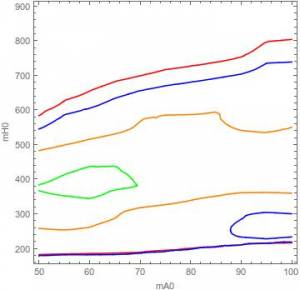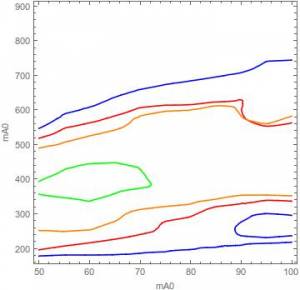Responsible: Jose Mi No
Members: Ken Mimasu, Werner Porod, Jérémy Bernon, Andrey Katz, Dipan Sengupta, Sanjoy Biswas
In the context of 2HDM, there is no a priory reason to expect that the neutral states A0, H0 should be close in mass, only one of the two has to be relatively close in mass to H+ due to T-parameter constraints. When |m_A0 - m_H0| > m_Z and/or |m_H+ - m_{H0/A0}| > m_W, various possible decays open: (depending on the spectrum) A0 → H0 Z, H0 → A0 Z, H+ → H0 W+, H+ → A0 W+, A0 → H+ W-, H0 → H+ W- (other possible non-SM decays which appear for a sizable mass splitting are H0 → A0 A0 and H0 → H+ H-).
These decays typically dominate the Br of the mother particle when the splitting is large, on one side weakening searches of the mother particle via other Br, on the other providing a new discovery mode for both mother and daughter particles (usually very clean).
Project:
- Assume light A0 scenario for 2HDM (m_A0 < 100 GeV, e.g. http://arxiv.org/abs/1412.3385). For TypeII 2HDM, a large splitting m_H0 - m_A0 ~ 200-300 GeV is required. For TypeI 2HDM, sizable m_H0 - m_A0 is not required but perfectly possible. In both cases, g g → H0 → Z A0 → ll bb could probe this scenario for low tan_beta (< 5) as a complementary search to bbA0 (lowmassa).
- Use http://cds.cern.ch/record/2014119 to extract the limits on tan_beta in the (m_A0,m_H0) plane, in the 2HDM alignment limit:
The plot below shows the excluded regions for Type I (left) and Type II (right): (red → t_beta = 0.5; blue → t_beta = 1; orange → t_beta = 1.5; green → t_beta = 2)
Regarding the interplay/contamination of bbH0 in the gg channel…
- LHC14 Prospects and interplay with bbA0
Literature:
Light A/H:
- http://arxiv.org/abs/1412.3385: A detailed analysis of the 2HDM allowed region for a light A0 (20 GeV < m_A0 < 60 GeV), both in TypeI and TypeII. It also has a discussion of detection prospects in bbA0 and gg→A0 for “aligment” and “wrong-sign” scenarios, showing that in particular for TypeII the “wrong-sign” can be completely explored with bbA0.
Sizable Splitting in 2HDM and A→ZH/H→ZA:
- http://cds.cern.ch/record/2014119: CMS has recently carried on a search of A0 → Z H0 / H0 → Z A0 in ll bb, ll tautau final states. This search constraints values of tan_beta up to 4 for some (m_A0, m_H0) values with a sizable splitting.
- http://arxiv.org/abs/1405.5537: A physical motivation for a large mass splitting m_A0 - m_H0 ~ 200-300 GeV and the search for A0 → Z H0 at LHC is provided: this large splitting leads to a strong EW phase transition in the early universe, which could be responsible for the generation of the observed matter-antimatter asymmetry via EW baryogenesis. It also analyzes LHC14 search prospects for A0 → Z H0 in ll bb and ll W W (W → l nu).
- http://arxiv.org/abs/1404.1922: Detailed discussion of LHC14 search prospects for A0 → Z H0 in both ll bb and ll Z Z, and H0 → Z A0 in ll bb.
Constraints on 2HDM (e.g. Flavour):
- http://arxiv.org/abs/1208.2788 Bounds on m_H+ from b → s gamma, both for Type I and Type II. They show that for Type II, the bound is particularly strong (m_H+ > 380 GeV) and tan_beta independent.

